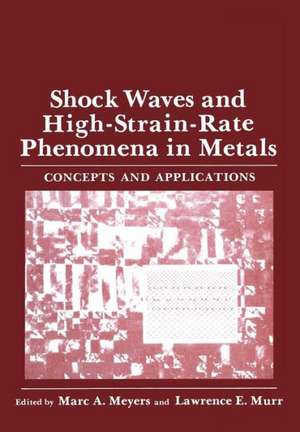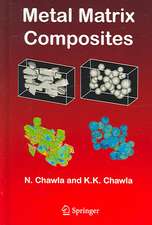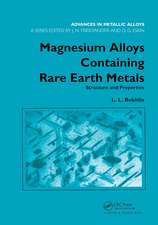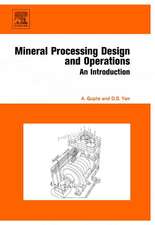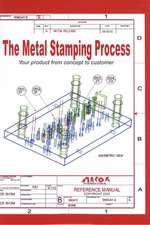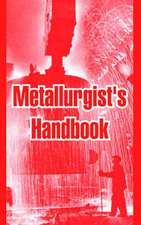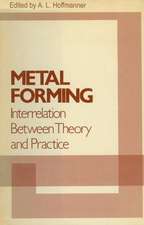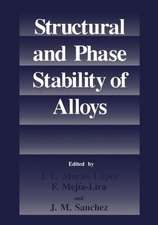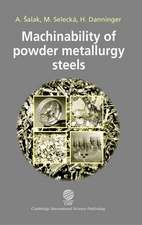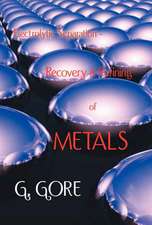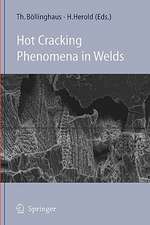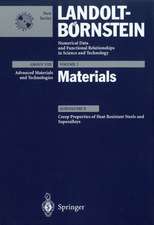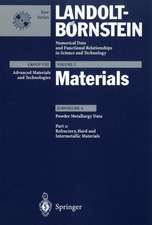Shock Waves and High-Strain-Rate Phenomena in Metals: Concepts and Applications
Editat de Mare Meyersen Limba Engleză Paperback – 12 oct 2011
Preț: 990.60 lei
Preț vechi: 1208.05 lei
-18% Nou
Puncte Express: 1486
Preț estimativ în valută:
189.56€ • 195.85$ • 157.69£
189.56€ • 195.85$ • 157.69£
Carte tipărită la comandă
Livrare economică 20 martie-03 aprilie
Preluare comenzi: 021 569.72.76
Specificații
ISBN-13: 9781461332213
ISBN-10: 1461332214
Pagini: 1120
Ilustrații: XIII, 1101 p.
Dimensiuni: 170 x 244 x 59 mm
Greutate: 1.74 kg
Ediția:Softcover reprint of the original 1st ed. 1981
Editura: Springer Us
Colecția Springer
Locul publicării:New York, NY, United States
ISBN-10: 1461332214
Pagini: 1120
Ilustrații: XIII, 1101 p.
Dimensiuni: 170 x 244 x 59 mm
Greutate: 1.74 kg
Ediția:Softcover reprint of the original 1st ed. 1981
Editura: Springer Us
Colecția Springer
Locul publicării:New York, NY, United States
Public țintă
ResearchCuprins
Section 1: Historical Perspective.- 1 Historical Perspective: Metallurgical Effects of High Strain Rate Deformation and Fabrication.- Section 2: High Strain-Rate Deformation.- 2 An Improved Technique for Determining Dynamic Material Properties Using the Expanding Ring.- 3 Comparison of Flow Curves of 6061 Aluminum Alloy at High and Low Strain Rates.- 4 Dynamic Behavior of High Strength Steels Under Tension.- 5 Plastic Deformation of Colliding Hemishells.- 6 Deformation Mechanisms of Impact-Loaded Tungsten Sinter Materials.- 7 Effects of Strain Rate on Deformation - Induced Martensite in 304 Stainless Steel.- 8 Some Metallurgical Aspects of the Dynamic Expansion of Shells.- Section 3: Dynamic Fracture.- 9 Linking Dynamic Fracture to Microstructural Processes.- 10 Internal Fractures in Solids of Revolution due to Stress Wave Focussing.- 11 Application of Survival Statistics to the Impulsive Fragmentation of Ductile Rings.- 12 The Effect of Strain History on Crack Initiation Under Dynamic Loading.- 13 A Study of the Material Failure Mechanisms in the Shear-Control Process.- Section 4: Adiabatic Shearing.- 14 Adiabatic Deformation and Strain Localization.- 15 Metallurgical Influences on Shear Band Activity.- 16 Formation of Adiabatic Shear Bands During Upsetting of 18-4-1 Alloy Steel at High Strain Rates.- 17 A Criterion for Thermo-Plastic Shear Instability.- 18 Material Factors in Adiabatic Shearing In Steels.- 19 Shear Strains, Strain Rates, and Temperature Changes in Adiabatic Shear Bands.- 20 Description of “Hot Spots” Associated with Localized Shear Zones in Impact Tests.- 21 Metallurgical Effects on Impact Loaded Materials.- Section 5: Shock Waves I: Experimental Techniques.- 22 Design of Uniaxial Strain Shock Recovery Experiments.- 23 Active Measurements ofDefect Processes in Shock-Compressed Metals and Other Solids.- 24 Determination of Pressure in a Metal Plate at Propagation of Loading Over the Plate Surface.- 25 A Technique for the Generation of Pressure-Shear Loading Using Anisotropic Crystals.- 26 Determination of the Shear Strength of Shock Compressed 6061-T6 Aluminum.- 27 Attenuation of Shock Waves in Nickel.- 28 Generation of a Pressure Pulse for Dislocation Velocity Studies.- Section 6: Shock Waves II: Fundamentals.- 29 Moving Dislocations in the Shock Front.- 30 Defect Generation in Shock-Wave Deformation.- 31 Mechanisms of Deformation Under Shock Loading.- 32 Dislocation Generation in Pure Aluminum at Quasistatic and Shock Loading.- 33 Thomas - Fermi Approximation for Shock Wave Structure in Metals.- 34 Response of Polycrystalline Mar-M200 (A Nickel Base Superalloy) to Shock Loading.- 35 Investigation of Shock-Loaded Copper by Positron Annihilation.- 36 Dislocation Drag Mechanisms, High Velocity Dislocations, and Twinning.- Section 7: Shock Waves III: Microstructural and Mechanical Effects.- 37 Residual Microstructure - Mechanical Property Relationships in Shock-Loaded Metals and Alloys.- 38 Effects of Laser-Induced Shock Waves on Metals.- 39 Short Duration Shock Pulses as a Tool to Study the Time Dependence of Plastic Deformation.- 40 Shock-Induced Martensite Reversal in Fe-30%Ni.- 41 Repeated Shock Loading of Nickel and Stainless Steel.- 42 Effects of Peak Pressure, Pulse Duration, and Repeated Loading on the Residual Structure and Properties of Shock Deformed Metals and Alloys.- 43 Magnetic Properties and Microstructures Associated With the Shock-Induced Transformation of fcc Iron to bcc Iron.- 44 Investigation of Residual Change Stability in Structure and Properties of Internally Oxidized Cu-A?203Alloys After Loading by Plane Shock Waves.- 45 Thermomechanical Processing by Shock Waves: An Overview.- Section 8: Dynamic Compaction of Powders.- 46 Fundamentals of Explosive Compaction of Powders.- 47 Formation Mechanism of Metallurgical Inhomogeneities Accompanying Shock Compaction of Porous Metals.- 48 Response of Metal Powders to High Transient Electrical Discharge.- 49 Metallurgical Effects Under Shock Compression of Powder Materials.- 50 Observation of Dislocations and Twins in Explosively Compacted Alumina.- 51 The Production of Strong Parts and Non-Equilibrium Alloys by Dynamic Compaction.- Section 9: Explosive Metal Working and Welding.- 52 Explosive Metal Working in the U.S.S.R..- 53 Explosive Welding - A Review.- 54 Microstructure and Bonding Mechanism in Explosive Welding.- 55 Influence of Collision Parameters on the Morphology of Interface in Aluminum-Steel Explosion Welds.- 56 Recrystallization of Explosively Formed Sheet Metal Parts out of Brass and Aluminum.- 57 Interfacial Wave Generation in Explosive Welding of Multilaminates.- 58 Fracturing of Embrittled Steel Vessels Into Preformed Fragments by Impulsive Loading.- Appendixes.- Appendix A Summary of Properties and Characteristics of Explosives.- Appendix B Temperature Rises Due To Shock Waves.- Appendix C Essential Equations on Shock Waves and How To Obtain Rankine-Hugoniot Plots for Metals.- Appendix D How to Obtain Hugoniot Relationships for Alloys.- Appendix E Nomograph for Determination of Flyer-Plate Velocity.- Appendix F Tabulation of Shock Wave Parameters as a Function of Pressure.- Appendix G Calculation of Rarefaction and Attenuation Rates of Shock Waves.- Contributors.
